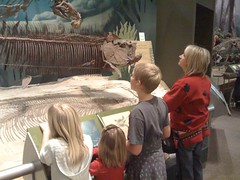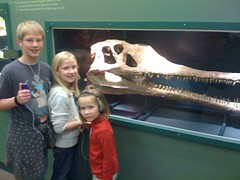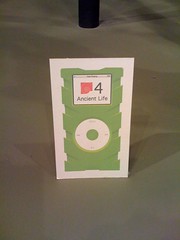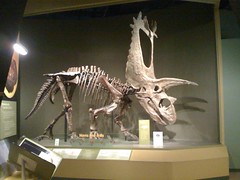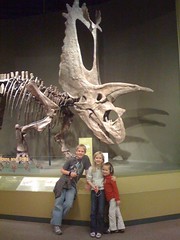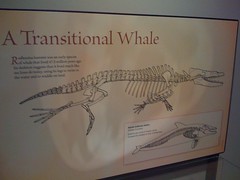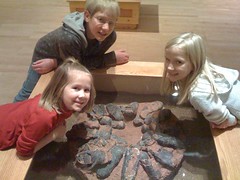For several months now, my five year old has been telling everyone who asks about her future career path that she wants to be a paleontologist and study dinosaurs. (Certainly not unusual for a child her age!) As we considered ways to ring in the new year as a family, given her interest in dinosaurs it seemed natural to spend New Year’s Eve at the Sam Noble Oklahoma Museum of Natural History in Norman, Oklahoma, about a half hour drive south from where we live. This photo shows Rachel and other children energetically “digging” in the museum’s “discovery room.”
Prior to leaving for the museum, I downloaded the ten part audio tour for the Sam Noble museum for the “Ancient Life” permanent exhibit. This turned out to be a fantastic addition and learning element to our museum visit.
The museum has small iPod signs around the “Ancient Life” exhibit to indicate which part corresponds to different segments of the iPod audio tour.
Unfortunately, however, some jokester (I assume) moved all of them to different locations, so none are in the correct spot. (As of our tour on 12/31/2008.) It wasn’t too difficult, however, to ignore the signs and read the podcast segment titles on our iPods and find the correct segment for each museum area.
One of the highlights for me personally was seeing the largest dinosaur skull ever discovered on the planet, to date, which is over ten feet tall! It was exciting to meet Pentaceratops!
This photo of Pentaceratops with my kids provides a sense of scale for this HUGE skull and full skeleton! Not all of the bones in this model are real, but many are including the skull. It was fun to look at him and figure out which bones were real fossils, and which were recreations.
From a learning perspective, there is NO DOUBT the availability of short “chunks” of information about the museum exhibits via the iPod audio tour meaningfully added to everyone’s learning in the “Ancient Life” area of the museum. Visits to traditional museums usually involve a LOT of reading for visitors who want to learn in-depth during their visit. Like a school textbook in many ways, exhibits are filled with text that must be read to be understood. The Sam Noble museum DOES offer both Spanish and English versions of many exhibit descriptions, but the primary communication modality for the bulk of museum information is still TEXT.
My 11 and 8 year old children could and did read some of the exhibit descriptions, but not my 5 year old. The 11 and 8 year olds, even though they read well, were still very limited in the amount of reading they did. By listening to 2-3 minute audio descriptions of various exhibit elements, however, they picked up on many specific details about the history, science, and creatures described in the exhibits which they would NOT have learned (IMHO) without the audio tour. The fact that we discussed what we had just heard following each of these iPod audio tour elements also helped reinforce different things we were told.
We synchronized four iPods of various ages to include this RSS media feed from the museum at our house before we left for our day’s adventures. Had we not had iPods or needed extra ones, we could have rented iPods from the museum for $2 each. As it was, my youngest two children used an iPod “y cable” and shared an iPod. At each museum station with an iPod audio tour recording, one of the kids gave an audible “countdown” and we all started our iPods on that recording at the same time. This way were were hearing the virtual museum guide at almost the same time, and we could react together to the things she said.
Karen Montgomery teaches workshops for educators on creating “podguides” similar to the one from the Sam Noble museum which we used. A Google keyword search for “podtours” reveals a variety of websites including iPod audio tours of different locations. I think facilitating student creation and sharing of iPod tours of different historical sites as well as local points of interest would be a great element to add to the StoryChasers project for 2009. Often when students assume the role of CONTENT CREATOR they can engage in more higher order thinking than when they are simply passive consumers of information. This can lead to greater transfer and retention of ideas than might otherwise take place as a result of a museum experience. For more on this, see Andrew Churches’ wiki page on the New Bloom’s Taxonomy and ICT.
Overall, our experiences at the Sam Noble museum yesterday were wonderful! They would have been great even without the iPod audio tour, but it certainly did add positively to visit and helped further insure our experiences there were educational as well as fun!
The museum has an extensive list of public lectures and other events planned for 2009, including the opening of a new exhibit for a recently discovered Oklahoma dinosaur even larger than Apatosaurus in January. I think chances are good we’ll be back! 🙂
Technorati Tags:
dinosaur, dinosaurs, museum, oklahoma, norman, ou, sam, noble, samnoble, natural, history, ipod, audio, tour, podguide, rss, podcast, feed, media, iphone, itouch, podtour, travel


